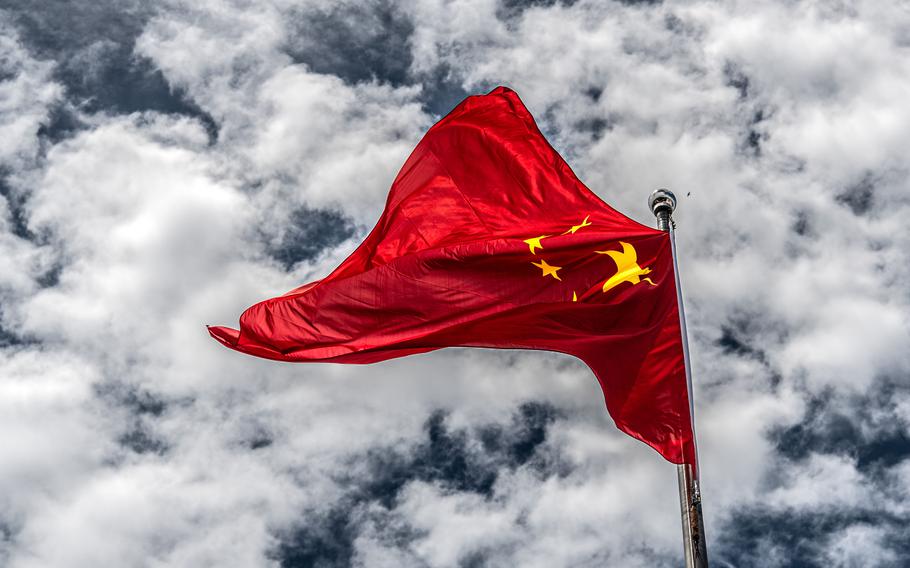
A Chinese flag flies above the Chinese Embassy in Washington, D.C., on July 6, 2022. (Carlos Bongioanni/Stars and Stripes)
China sent scores of warships and aircraft into the contested Taiwan Strait this week, a likely response to the passage of a U.S. destroyer and Canadian frigate there over the weekend, according to a security expert.
Between 6 a.m. Sunday and 6 a.m. Monday, 39 Chinese aircraft and 13 ships were active around Taiwan, according to a series of posts by Taiwan’s Ministry of National Defense on X, formerly known as Twitter.
Thirteen aircraft crossed the median line or entered Taiwan’s air defense identification zone, but none went into the island’s territorial space, according to the posts.
Taiwan’s ships and defense systems tracked another 22 aircraft and 20 vessels on Tuesday, according to the ministry. China’s military presence was the most in the strait since Sept. 2, when it sent six aircraft and three ships there.
China’s heightened activity is probably its response to the U.S. guided-missile destroyer USS Ralph Johnson and the Canadian frigate HMCS Ottawa transiting the strait together on Saturday, said Norah Huang, director for international relations at the Prospect Foundation, a security and foreign affairs think tank in Taipei.
China considers the 110-mile-long Taiwan Strait to be its territorial waters, and Beijing’s actions were intended to “back up” that claim, she told Stars and Stripes by email Tuesday.
Chinese aircraft also spent more time across the strait’s median line, which Huang said is “stepping up the level of aggressiveness.”
Chinese naval vessels were busy elsewhere in the same period.
The Shandong, Beijing’s first domestically built aircraft carrier, passed about 60 nautical miles southeast of Taiwan’s southernmost point, the island’s military said Monday in a post on X.
To the northeast, eight Chinese warships in two groups passed Monday through the Miyako Strait on Monday, according to Japan’s Joint Staff. The international waterway links the East China and the Philippine seas and is flanked by the Japanese islands of Miyako and Okinawa, according to Japan’s Joint Staff.
Three Chinese guided-missile destroyers and two frigates spotted by the Japan Maritime Self-Defense Force between 8 a.m. and 9 a.m. later transited the Miyako Strait, according to a news release Monday from the Joint Staff.
The Self-Defense Force confirmed another three Chinese guided-missile destroyers, spotted around 8 a.m. Monday about 90 miles northwest near Taisho Island, also passed through the strait, according to the release. Three Japanese ships and a P-3C Orion surveillance aircraft monitored those vessels.
Beijing considers Taiwan, a functional democracy, to be a breakaway province that must be reunified with the mainland.
Taiwan’s upcoming presidential election in January could be another motive for China to step up military activity around the island, Huang said. Taiwan anticipates similar “intimidation maneuvers” as the election campaigns go into full swing.
Huang said the Shandong’s presence serves as a reminder that China aims to project “its power beyond the first island chain.”
U.S. 7th Fleet spokesman Lt. Luka Bakic by email Tuesday declined to comment on the Saturday transit or China’s activities. He referred questions to the Pentagon, which had not responded to an email query as of early Tuesday in Washington, D.C.
The Ottawa plans to remain in the region and take part in exercises and other engagements, ship spokeswoman Lt. Cmdr. Christine Hurov said by email Tuesday.
“As a sustained and consistent presence in the region, the Royal Canadian Navy is demonstrating Canada’s commitment to a free and open Indo-Pacific,” she wrote.